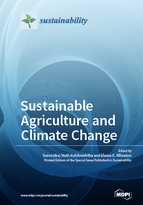Sustainable Agriculture and Climate Change
A special issue of Sustainability (ISSN 2071-1050). This special issue belongs to the section "Sustainable Agriculture".
Deadline for manuscript submissions: closed (30 April 2017) | Viewed by 87600
Special Issue Editors
Interests: water resource economics; climate change; agro-forestry; economic impact assessment
Special Issues, Collections and Topics in MDPI journals
2. Emeritus Researcher, Saskatchewan Research Council, Saskatoon, SK S7N 2X8, Canada
Interests: climate change; agriculture; climate extremes; environmental science; sustainable development; climate impacts; adaptation; vulnerability
Special Issue Information
Dear Colleagues,
This Special Issue would cover topics related to climate change and its relationship with the sustainability of agriculture. Sustainability (and sustainable development) covers environmental, social and economic dimensions, and requires a multi-disciplinary approach in order to examine, explore and critically engage with issues and advances in these and related areas. There is a need to examine the three pillars of sustainability in the context of agriculture and its interplay with climate change. As we are aware, climate change is a certainty and it affects many economic sectors, including agriculture. It would affect production, such as crop and livestock, differently. Vast regional differences are expected for various parts of the world. Trade patterns may change, and the entire supply chains may require reorganization. Overall, the economic fortunes of producers in different parts of the world would be affected. These distributive effects could even threaten food security in certain parts of the world. Agricultural sustainability may be especially threatened by climate extremes, such as heat waves, droughts, and floods. However, not all changes induced by climate change would be negative; some may even be positive. Undoubtedly, there would be gainers and losers within a nation, as well as among countries. Gains and losses would also change with time, depending on the various climate thresholds reached, for example. Achieving sustainability would require changes in the way we manage agriculture. Therefore, equally important in this discourse is to find solutions to achieve sustainability in the wake of climate change, one of the major threats to sustainability. Papers selected for this Special Issue will be subject to a rigorous peer review procedure with the aim of rapid and wide dissemination of research results, developments and applications.
Prof. Dr. Suren N. Kulshreshtha
Prof. Elaine Wheaton
Guest Editors
Manuscript Submission Information
Manuscripts should be submitted online at www.mdpi.com by registering and logging in to this website. Once you are registered, click here to go to the submission form. Manuscripts can be submitted until the deadline. All submissions that pass pre-check are peer-reviewed. Accepted papers will be published continuously in the journal (as soon as accepted) and will be listed together on the special issue website. Research articles, review articles as well as short communications are invited. For planned papers, a title and short abstract (about 100 words) can be sent to the Editorial Office for announcement on this website.
Submitted manuscripts should not have been published previously, nor be under consideration for publication elsewhere (except conference proceedings papers). All manuscripts are thoroughly refereed through a single-blind peer-review process. A guide for authors and other relevant information for submission of manuscripts is available on the Instructions for Authors page. Sustainability is an international peer-reviewed open access semimonthly journal published by MDPI.
Please visit the Instructions for Authors page before submitting a manuscript. The Article Processing Charge (APC) for publication in this open access journal is 2400 CHF (Swiss Francs). Submitted papers should be well formatted and use good English. Authors may use MDPI's English editing service prior to publication or during author revisions.
Keywords
- Sustainability
- agricultural production
- agricultural sustainability
- climate change
- climate extremes
- climate variability
- threats to sustainability
- adaptation measures
- regional differences
- carbon dioxide effect
- green agriculture
- crops
- livestock
- soils
- water
- management for sustainability
- climate-smart agriculture
- food security







